Satanoperca daemon
Threespot Eartheater
SynonymsTop ↑
Geophagus daemon Heckel, 1840
Etymology
Satanoperca: from the Ancient Greek Σατάν (Satán), meaning ‘Satan’ (the devil), and πέρκη (pérkē), meaning ‘perch’.
daemon: from the Ancient Greek δαίμων (daímōn), meaning ‘dispenser, god, protective spirit’.
Classification
Order: Perciformes Family: Cichlidae
Distribution
Native to the rio Negro watershed in the western Amazon basin of Amazonas state, Brazil, plus the Casiquiare and upper Orinoco systems in Venezuela and Colombia, including the ríos Uaupés, Pasiba, Atabapo, Guaviare, Inírida, Vichada, Sipapo, Tomo, Autana, Tuparro, Ventuari, Parguaza, and Cinaruco.
Reports from elsewhere in the Amazon basin appear to represent cases of misidentification.
Type locality is ‘Rio Negro at Maribitanos, Amazonas, Brazil’.
Habitat
Mostly observed in acidic, mineral-poor blackwater environments with brownish, tannin-stained water.
A typical example is the Río Cinaruco, a low nutrient tributary of the Orinoco in southwestern Venezuela comprising a meandering river channel with numerous lagoons and floodplain lakes which become connected during the annual wet season, when water levels can rise by several metres.
S. daemon tends to aggregate and breed in these marginal water bodies, where water flow is much reduced to non-existent. Substrates are primarily sand, leaf litter and fallen branches, although aquatic vegetation proliferates in places.
Other fishes occurring in the upper Orinoco basin and available in the aquarium trade include Corydoras delphax, Platydoras costatus, Baryancistrus beggini, Hypancistrus inspector, Panaqolus maccus, Panaque nigrolineatus, Hemigrammus rhodostomus, H. stictus, Hyphessobrycon sweglesi, Paracheirodon axelrodi, Pristella maxillaris, Copella nattereri, Heros severus, Mesonauta insignis, Biotodoma wavrini, and Uaru fernandezyepezi.
Maximum Standard Length
200 – 250 mm.
Aquarium SizeTop ↑
An aquarium with a base measuring at least 210 ∗ 60 cm or equivalent is required.
Maintenance
The most essential item of décor is a soft, sandy substrate so that the fish can browse naturally (see ‘Diet’).
Coarser materials such as gravel or small pebbles can inhibit feeding, damage gill filaments and even be ingested with the potential of internal damage or blockages.
Additional furnishings are as much a case of personal taste as anything else but the most favoured set-ups tend to feature relatively dim lighting plus some chunks of driftwood and scattered roots or branches.
Leaf litter is a typical feature of the natural environment but not really recommended in aquaria because the feeding behaviour of Satanoperca spp. tends to cause an excess of partially-decomposed material in suspension which not only looks unsightly but can block filter and pump mechanisms.
Water quality is of the utmost importance since these cichlids are extremely susceptible to deteriorating water quality and swings in chemical parameters so should never be introduced to a biologically immature aquarium. S. daemon also requires soft, acidic conditions and in most cases will not thrive in untreated tap water.
The best way to achieve the desired stability is to filter the tank using a combination of external canister filters and/or a sump system and perform minimum weekly water changes of 50-70%.
If the maintenance regime is insufficient health issues such as head and lateral line erosion or stunted growth can occur.
Mechanical filtration should also be tailored to trap small particles stirred up by the fish as sand can cause blockages and wearing issues with filter mechanisms if allowed to continually run through the system.
High flow rates should be avoided so position filter returns accordingly.
Water Conditions
Temperature: 24 – 28 °C
pH: 3.5 – 6.0
Hardness: 18 – 90 ppm
Diet
Satanoperca spp. are benthophagous by nature, employing a method of feeding whereby mouthfuls of substrate are taken and sifted for edible items with the remaining material expelled via the gill openings and mouth. For this reason they are commonly termed ‘eartheaters’ and the provision of a suitable substrate is essential to their long-term well-being. Once settled they readily rise into the water column when food is introduced but continue to browse normally at other times.
The stomach contents of wild specimens mostly comprise small aquatic and terrestrial invertebrates including cladocerans, ostracods, and insect larvae (particularly chironomids), plus plant material (seeds), organic detritus and sediment.
Even large individuals seem unable to properly ingest larger food items, meaning the diet should contain a variety of high quality, fine-grade prepared foods plus small live or frozen bloodworm, Tubifex, Artemia, mosquito larvae, etc. At least some of the dried products should contain a high proportion of vegetable matter such as Spirulina or similar.
Home-made, gelatine-bound recipes containing a mixture of dried fish food, puréed shellfish, fresh fruit and vegetables, for example, are proven to work well and can be cut into bite-sized discs using the end of a sharp pipette or small knife.
Rather than a single large meal offer 3-4 smaller portions daily to allow natural browsing behaviour as this seems to result in the best growth rate and condition.
Behaviour and CompatibilityTop ↑
Unless breeding this species is surprisingly peaceful and will not predate on fishes larger than a few millimetres in length. Suitable tankmates are numerous and include most peaceful species enjoying similar environmental conditions. Best avoided are aggressive or territorial substrate-dwelling species, or those requiring less acidic or mineral-rich water.
Some aquarists keep Satanoperca spp. alongside freshwater stingrays of the genus Potamotrygon which in many cases has proven successful but in some has resulted in the cichlids disappearing at night.
S. daemon is gregarious and tends to exist in loose aggregations unless spawning, with juveniles in particular displaying strong grouping instincts. A group of 5-8 individuals should be the minimum purchase and these will form a noticeable dominance hierarchy. When maintained in smaller numbers weaker specimens can become the target of excessive antagonism by dominant individuals or the group may fail to settle and behave nervously.
Sexual Dimorphism
No external differences have been observed other than gravid adult females appearing somewhat deeper-bodied than males, and during spawning when the ovipositor of the female is visible.
Reproduction
This species is a biparental substrate-spawner, but is very rarely-bred in aquaria. There does not appear to be any particular trigger for the spawning process with the main requirements being sufficient space, suitable diet and a stringent maintenance regime.
Since accurate sexing is very difficult it is perhaps best to begin with a group of young fish and allow pairs to form naturally, while a degree of patience is also required since it can be at least a year until they become sexually mature.
Courtship is relatively unobtrusive consisting of fin flaring, circling, gaping and head jerking displays. When ready to spawn a pair will select a suitable site and excavate a large pit which may measure as much as 2 metres by 1 metre if the space is available. This is usually defended by both fish for a number of days before a smaller site is selected within it just prior to spawning. Other fishes, especially conspecifics, are not tolerated in the vicinity and in smaller aquaria may need to be removed.
The spawning surface is normally a solid object within the territory of the pair and is cleaned thoroughly before any eggs are deposited. Spawning occurs in slightly atypical style with the female extruding batches of eggs before the male moves in to fertilise them, the process being repeated numerous times until 200 or more eggs have been deposited.
The adults tend to cover the brood with a layer of leaves, wood, or substrate, and while both male and female participate in brood care it is the latter that spends the most time tending the eggs, while the male is also responsible for defence of the surrounding territory.
After around 3 days (70 hours at 27°C/80.6°F) the eggs begin to hatch and the adults uncover the fry, which become free-swimming around 48 hours post-hatching.
Post-hatching both adults normally continue to guard the fry for a period although in some cases the female continues alone. The fry are able to accept Artemia nauplii, microworm, etc. as soon as the free-swimming stage is reached. Alternatively, the eggs can be siphoned out of the aquarium and hatched elsewhere.
NotesTop ↑
S. daemon is relatively common in the aquarium trade but is by no means easy to maintain, with particular attention to space, diet, water quality, and chemistry required in order for it to thrive.
It can be distinguished from other members of the genus by possessing two dark blotches on the flank and a prominent ocellus at the caudal-fin base. Among the named species it is most similar to S. lilith, but that species possesses only a single blotch on the flank.
Satanoperca was considered a synonym of Geophagus for a number of decades before being revalidated by Kullander (1986). It is separated from all other members of the putative cichlid subfamily Geophaginae by presence of a small ocellated spot at the upper caudal-fin base, and from Geophagus by a number of morphological characters as follows: equal numbers of abdominal and caudal vertebrae or one more abdominal vertebra (vs. more caudal than abdominal vertebrae in Geophagus); no ribs on caudal vertebrae and no postabdominal swimbladder extensions (vs. presence of both in Geophagus; cheek scaled rostrally to centre (vs. naked on anterior half; dorsal and anal fins naked (vs. scaled); external gill rakers on lower limb of first gill arch attached to the skin covering the gill filaments (vs. attached to ceratobranchial skin); jaw dentition reduced to one or two short series in each jaw (vs. pluriseriate with wide band of inner teeth); absence (vs. presence) of tooth plates on 4th ceratobranchial; presence (vs. absence) of an ocellus on caudal-fin base; both or only upper lip fold continuous (vs. both interrupted anteriorly); preoperculum and supracleithrum frequently serrated (vs. entire); absence (vs. presence) of median hypural cartilage; 3 (vs. 4) infraorbitals.
The genus is likely to contain additional species, and has been separated into three groups with distinctive morphology, namely the S. jurupari group, the S. daemon group, and the monotypic S. acuticeps group.
Among these, members of the S. jurupari group are characterised by a colour pattern comprising a dark lateral stripe or row of blotches along the side of the body, normally XV.10 (XIV-XVII.8-11) dorsal-fin rays, normally 27 (26-28) E1 scales (the longitudinal row immediately above the lower lateral line, excluding the pectoral girdle), and 12-18 rakers on the first gill arch.
S. daemon group members grow larger than other congeners, possess one or two large dark blotches on the side of the body and a prominent ocellus at the upper caudal-fin base, usually XIX.13 (XII-XIV.12-14) dorsal-fin rays, 29-31 E1 scales, and 18-22 gill rakers. S. acuticeps is unique in that it has a relatively more terminal mouth than all other genus members, normally XIII.12 (XIII.11-12) dorsal-fin rays, 27-28 E1 scales, and 17-20 gill rakers.
The groups also differ in reproductive strategy, with the S. daemon and S. acuticeps assemblages being substrate spawners, and the S. jurupari group mouthbrooders.
The monophyly of both the S. daemon group and S. daemon itself are well-supported in phylogenetic studies, although S. lilith has been shown to display greater genetic diversity, with a degree of separation between populations from the rio Negro and those from Amazon tributaries further downstream.
Satanoperca and a number of related genera are often included in the putative subfamily Geophaginae, and Kullander (1998) conducted a morphology-based phylogenetic study in which the neotropical Cichlidae was divided into six subfamilies of which the Geophaginae contained 16 genera divided among three ‘tribes’:
Acarichthyini – Acarichthys and Guianacara.
Crenicaratini – Biotoecus, Crenicara, Dicrossus and Mazarunia.
Geophagini – Geophagus, Mikrogeophagus, ‘Geophagus‘ brasiliensis group, ‘Geophagus‘ steindachneri group, Gymnogeophagus, Satanoperca, Biotodoma, Apistogramma, Apistogrammoides and Taeniacara.
Later molecular studies by Farias et al. (1999, 2000, 2001) resulted in the additions of Crenicichla and Teleocichla to the Geophaginae, a result supported by López-Fernández et al. (2005) who conducted the most detailed molecular analysis of the grouping to date including 16 of the 18 genera and 30 species.
However their conclusions regarding interrelationships between genera did vary somewhat from previous hypotheses and can be summarised by the following loosely-defined groups:
– a weakly-supported sister group relationship between Acarichthys and Guianacara.
– a well-supported ‘Satanoperca clade’ comprising Satanoperca, Apistogramma, Apistogrammoides and Taeniacara.
– a ‘big clade’ with Geophagus, Mikrogeophagus, ‘Geophagus‘ brasiliensis group, ‘Geophagus‘ steindachneri group, Gymnogeophagus, Biotodoma, Crenicara and Dicrossus.
– a ‘crenicarine clade’ with Biotoecus and Crenicichla.
No representatives of Teleocichla or Mazarunia were included in the study but the former is well-established as sister to Crenicichla while the latter has grouped closely with Dicrossus and Crenicara in earlier works.
The other main conclusions of the paper are confirmation that Geophaginae is a monophyletic group exhibiting strong signs of having undergone rapid adaptive radiation.
References
- Heckel, J. J., 1840 - Annalen des Wiener Museums der Naturgeschichte v. 2: 325-471
Johann Natterer's neue Flussfische Brasilien's nach den Beobachtungen und Mittheilungen des Entdeckers beschrieben (Erste Abtheilung, Die Labroiden). - Gosse, J.-P., 1976 - Académie Royal des Sciences d'Outre-Mer, Cl. Sci. Nat. Méd. (N. S.) 19(3): 1-173
Révision du genre Geophagus (Pisces Cichlidae). - Günther, A., 1862 - Catalogue of the fishes in the British Museum v. 4: i-xxi + 1-534
Catalogue of the Acanthopterygii, Pharyngognathi and Anacanthini in the collection of the British Museum. - Kullander, S. O., 2012 - Cybium 36(1): 247-262
A taxonomic review of Satanoperca (Teleostei: Cichlidae) from French Guiana, South America, with description of a new species. - Kullander, S. O., 1986 - Swedish Museum of Natural History: 1-431
Cichlid fishes of the Amazon River drainage of Peru. - Kullander, S. O., 1998 - EDIPUCRS, Porto Alegre: 461-498
A phylogeny and classification of the South American Cichlidae (Teleostei: Perciformes). In: Malabarba, L. R. , R. E. Reis, R. P. Vari, Z. M. S. de Lucena and C. A. S. Lucena (eds). Phylogeny and classification of Neotropical fishes. - Kullander, S. O. and E. J. G. Ferreira, 1988 - Cybium 12(4): 343-355
A new Satanoperca species (Teleostei, Cichlidae) from the Amazon River basin in Brazil. - Kullander, S. O. and H. Nijssen, 1989 - E. J. Brill, Leiden: i-xxxii + 1-256
The cichlids of Surinam. Teleostei: Labroidei. - López-Fernández, H., R. L. Honeycutt, and K. O. Winemiller, 2005 - Molecular Phylogenetics and Evolution 34(1): 227-244
Molecular phylogeny and evidence for an adaptive radiation of geophagine cichlids from South America (Perciformes: Labroidei). - Newman, L. - Cichlid-Forum.com
Keeping & Breeding Satanoperca daemon (Heckel 1840). - Reis, R. E., S. O. Kullander and C. J. Ferraris, Jr. (eds), 2003 - EDIPUCRS, Porto Alegre: i-xi + 1-729
Check list of the freshwater fishes of South and Central America. CLOFFSCA. - Willis S. C., H. López-Fernández, C. G. Montaña, I. P. Farias, and G. Ortí, 2012 - Molecular Phylogenetics and Evolution 63(3): 798-808
Species-level phylogeny of ‘Satan’s perches’ based on discordant gene trees (Teleostei: Cichlidae: Satanoperca Günther 1862).

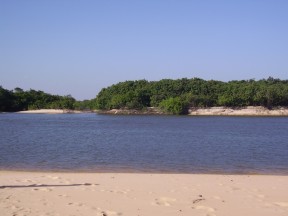


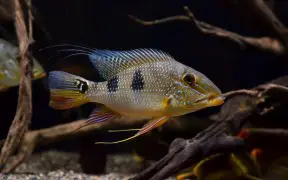
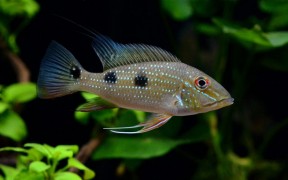
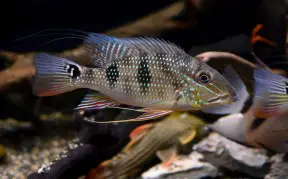
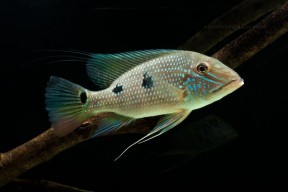
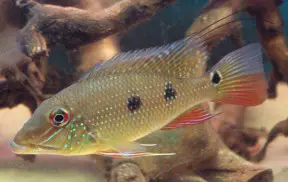

May 2nd, 2015 at 11:03 am
What is the source for this info:
“When ready to spawn a pair will select a suitable site and excavate a large pit which may measure as much as 2 metres by 1 metre if the space is available.”
and
“The adults tend to cover the brood with a layer of leaves, wood, or substrate, and while both male and female participate in brood care it is the latter that spends the most time tending the eggs, while the male is also responsible for defence of the surrounding territory.”
May 19th, 2015 at 8:07 pm
Hi Erik, I believe it was from the Newman reference that is now included above. An oversight on our part that it was not there before.